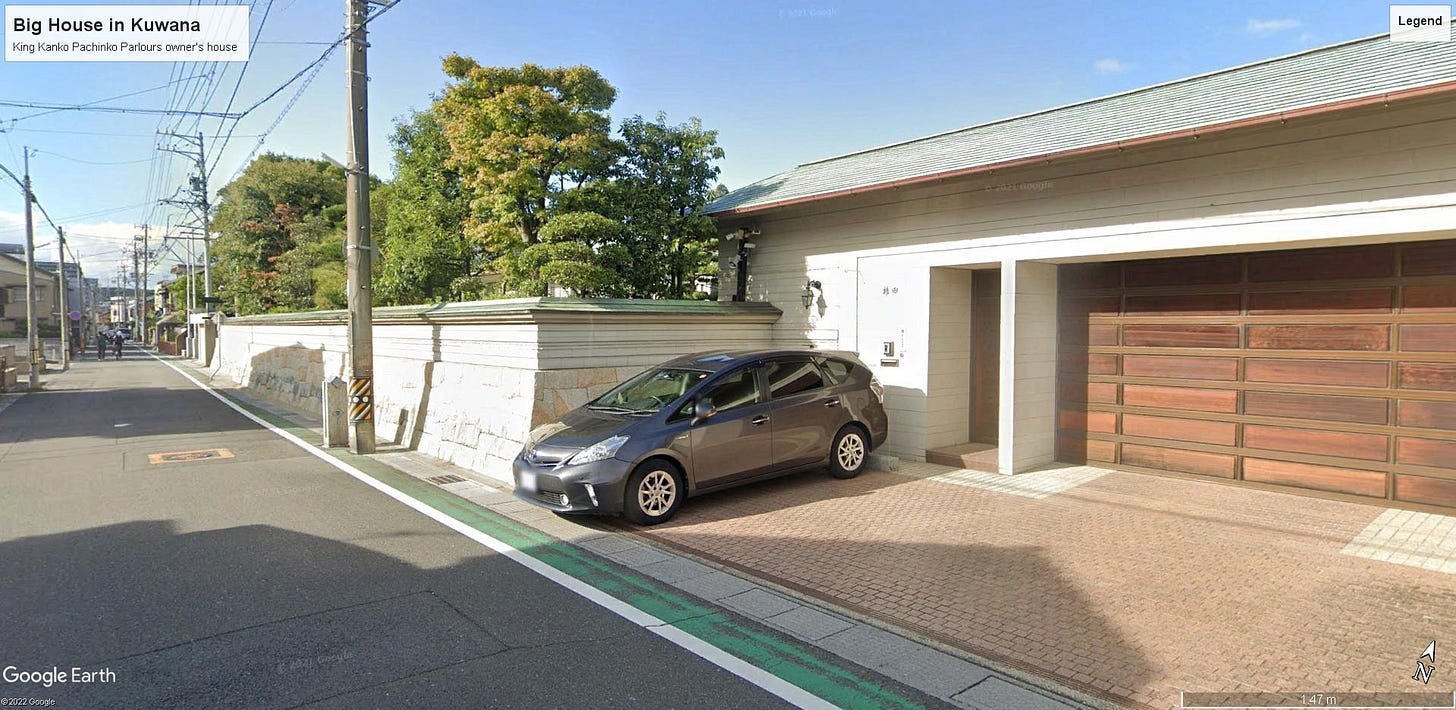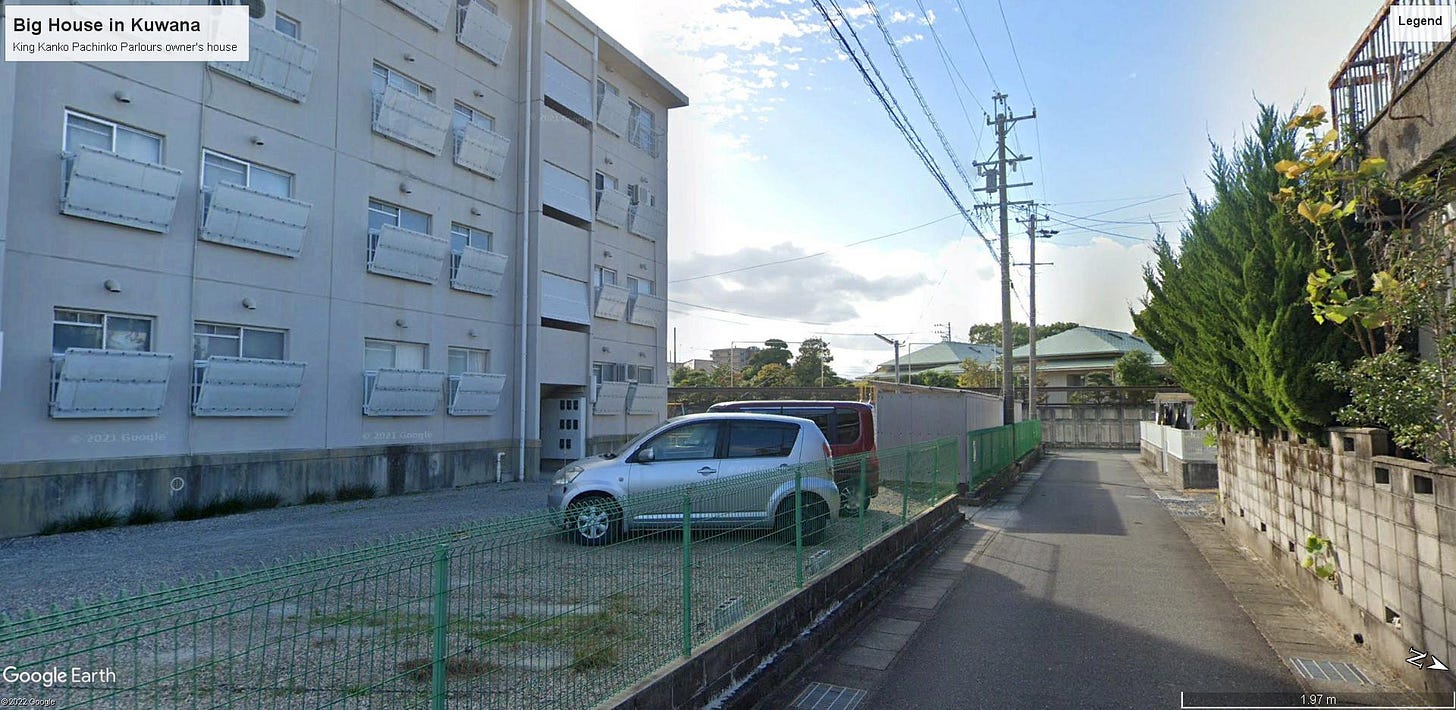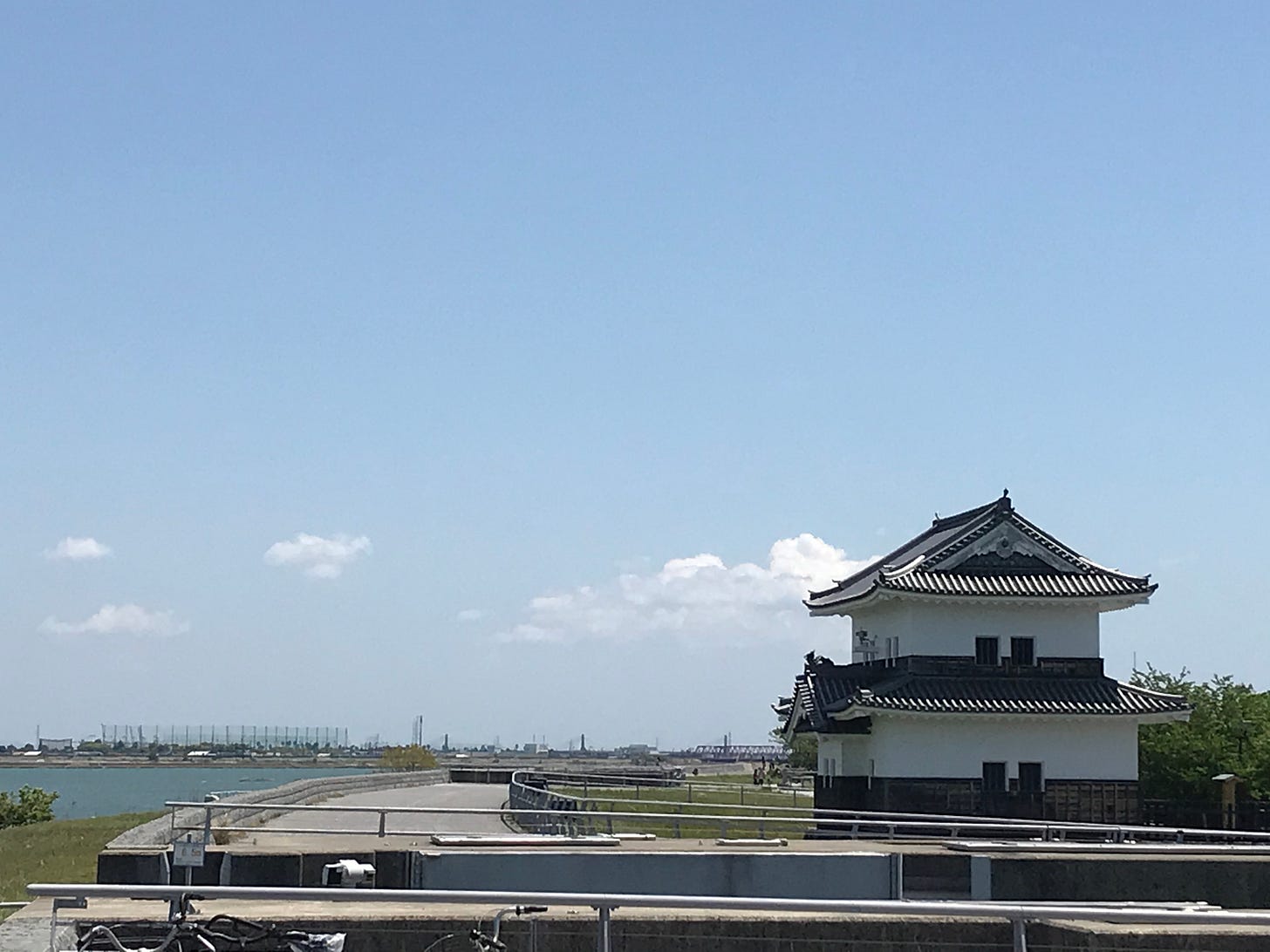I get maybe thirty minutes of sleep in my cold, wind-ruffled bivvy bag and get up as soon as it starts getting light. Once I’m on the move, I warm up quickly. Convenience store for breakfast, and then on through the interminable suburbs of Yokkaichi. Old houses, new houses, cinder block walls with bristly pines creeping over them, bamboo fences, plastic bamboo fences, and all the while, the day is heating up. The only breaks to the housing are a brief few fields between Yokkaichi and Kuwana, and a chain of factories on the outskirts of Yokkaichi.
The Utsube River where I spent the night, is the point on the Tokaido where pilgrims heading for the Ise shrine head south, while the Tokaido curves round to the west to begin its climb over the Suzuka Pass. In “Shank’s Mare” (Tokaido-chu Hizakurige), the two main characters, the Tokyo chancers Kita and Yaji, break off from their Tokaido journey here to make a detour to the Ise shrines. “Shank’s Mare” is a comic novel describing the adventures of the two protagonists as they make their way along the Tokaido from Tokyo to Kyoto. The adventures are the kind of thing you would find in a 1980s British Sitcom such as “Allo-Allo”. As they make their way from Kuwana to Utsube, Kita and Yaji are tricked by a room tout into staying in a decrepit inn, where they have to share a room with lots of other travellers. The room tout tells them that both the main inns (the honjin) are full, because a daimyo procession is passing through. In reality, it’s only a petty official passing through, who would barely take up even one of the honjin.
Entertainment at the inns is limited, travellers can take a bath and perhaps acquire the services of some of the servant girls who dabble in a little prostitution on the side. Kita thinks he has made an “arrangement” with the waiting girl who helps him with his bath. In the middle of the night, Yaji tries to steal Kita’s “arrangement” by sneaking off to the servant girl’s room, but in the dark knocks into a shelf which threatens to crash down, waking the whole inn. He ends up holding the shelf while Kita, who is now trying to make his way to his “arrangement” starts making his way to the servant girl’s room too. Yaji tricks Kita into holding the falling shelf, while he goes off to make good on the “arrangement”. Unfortunately, he enters the wrong room. The fellow travellers with whom Kita and Yaji are sharing a room are transporting a stone jizo statue to a temple in their home village. Yaji has crawled into the room with this jizo statue, and reaching out to touch what he thinks is the servant girl, touches the human-shaped stone. Thinking it’s a dead body, Yaji crawls back at high speed, passing Kita, who is still holding the shelf. In their panic, Kita drops the shelf, waking the whole inn. The landlord comes to find out what on earth is happening. After much embarrassment and amusement (why is Kita trying to have a “love adventure” with a statue), Kita and Yaji are forced to spill their story.
The comedy may not be the most sophisticated, the puns are usually lost in translation, but nevertheless, “Shank’s Mare” gives a good impression of life on the road at the beginning of the 19th century. Details such as the goods that various sellers bring to the inn to try and sell to the guests, and the regional specialities that Kita and Yaji eat as they travel along the Tokaido, show what travellers did and ate when they rested on their journeys. Sellers come to the inns and try to sell tobacco, toothbrushes and sake. It’s amazing how prevalent tobacco is in Japan by this time. Introduced by European traders sometime in the 16th century, tobacco in Japan had the advantage that it’s actually possible to grow it here. Hiroshige’s woodblock prints often show men of all social classes smoking tobacco in long-stemmed pipes known as kiseru. As they make their way past Yokkaichi, Kita and Yaji stop at a number of tea-houses where they eat baked clams cooked on burning pine cones.
James Clavell novels would have you believe that the lower classes were at constant risk of having their heads lopped off for the slightest error in etiquette when samurai passed by. Kita and Yaji however, happily chat to two passing samurai, to check the way, in what seems to be a pretty casual conversation. The only etiquette that seems to be followed is that a passing postboy dismounts from his horse as a sign of respect. Indeed, in Hiroshige’s prints, there are no images of cowering commoners as the daimyo processions pass.
Hiroshige’s print of Yokkaichi shows windswept reedbeds reminiscent of the Jersey shore where Paulie Gatto is executed in “The Godfather”. It’s hard to imagine that a lot of Japan looked as wild as this. The reedbeds are now covered with the oil storage tanks of Cosmo Oil’s Yokkaichi refinery. The suburban housing I’ve been passing through is described as “moorland” in “Shank’s Mare”. This flatland wilderness Japan only lives on in surnames such as Hara (grassy field/plain). Flatland became too precious to waste on grass or reedbeds. In the background of the print, the masts of boats that would make the ten ri (forty kilometre) crossing to Atsuta Shrine in Nagoya are visible. Not only was Ise a popular pilgrimage destination in the early 19th century, but Atsuta Shrine (also known as Miya) was heavily visited too. “Shank’s Mare” includes this song from the palanquin carriers:
Spread the sail and speed away, At Atsuta we wish to stay, What have you done with Hachibei? The horses ate him on the way! Dokkoi! Dokkoi!
Shank's Mare: A Translation of the Tokaido Volumes of Hizakurige: Japan's Great Comic Novel of Travel and Ribaldry, Iku Jippensha, Thomas Satchell, Tuttle Publishing, 2011
The factories I pass along the way to Kuwana include Toshiba’s Industrial Products and Systems (making motors and drives), Hitachi Metals, and on a hillside above, Kioxia’s semiconductor plant. It’s mighty hard to find out anything about Toshiba Industrial Products and Systems, separate from the rest of the Toshiba company itself. The skimpy financial results I could find show falling sales and profitability. The motors they make are pretty standard stuff, not at the forefront of the technology wave and probably face heavy competition from rivals overseas. The Toshiba group, after an accounting scandal in 2015, seems to have steadily declining revenues, but remains reasonably profitable.
Hitachi Metals, on the other hand, is at the edge of the technology wave, with advanced materials being used in all kinds of things, from electronic sensors to electric cars. Its sales pamphlets are filled with references to “monozukuri innovation”, its revenues are rising, and its profitability is stable.
Kioxia is actually a spinoff from Toshiba. It has just finished constructing a new semiconductor fab on the aforementioned hillside. After its spinoff, revenues have increased with the recovery in the market for NAND flash drives. The latest fab will keep Kioxia at the front of the NAND technology wave.
The oil refinery that dominates the seaboard of Yokkaichi is owned by Cosmo Energy Holdings. With a declining population and the rise of electric vehicles, the volume of oil processed by Cosmo’s refineries is steadily falling. Seibu Oil is closing one of its refineries in Yamaguchi prefecture, and Cosmo’s refineries seem to run below the industry average levels as if they are not worth investing in.
As I approach the end of my walk in Kuwana, I pass what is by Japanese standards, in fact by any standards, an enormous house. It’s discreetly hidden by a large wall, but I can still tell the place is huge. When I look at it on Google Earth it is about 1250 square metres. Houses like this are as rare as hen’s teeth in Japan. Who lives there? I assumed it was the mayor of Kuwana or somebody of that stature. However, after a bit of internet digging, it turns out that it is the mansion of the owner of a chain of pachinko parlours (King Kanko) across central Mie prefecture. There’s clearly money in pachinko. In other countries, this house would be in a discreet residential estate far from the hoi polloi, but in Japan it’s slap bang in the centre of town, next to a shabby apartment building, looking straight into his mansion compound, that probably contains some of his best customers.
Front entrance of King Kanko Pachinko owner’s house, by far the biggest house I’ve ever seen in Japan!
Shabby apartment building (sorry residents!) with pachinko owner’s mansion roof and wall in the background
The end of today’s walk is Kuwana Castle, the beginning of the seven ri (28 kilometres) crossing point to Atsuta in Nagoya. The castle park seems to be full of East Asian tourists (how have they got in, mid-pandemic?). I potter around for a while, looking inside a reconstruction of one of the castle towers, the main castle having burned down long ago, and a smaller-scale one burned down by government forces during the Meiji Restoration. My feet are hot and knackered, and as I hobble back to the station, I vow never to wear hiking boots again while walking the Tokaido. They’re too heavy, overkill for roadwalking, the only reason I’m wearing them is because I can rely on them not to give me any blisters.











It's funny you mentioned "Shank's Mare." I just discovered it a few months ago at the library. I only read the parts about places I passed during my 2019 trip but it's pretty funny.